
SKIING HISTORY
Editor Kathleen James
Art Director Edna Baker
Contributing Editor Greg Ditrinco
ISHA Website Editor Seth Masia
Editorial Board
Seth Masia, Chairman
John Allen, Andy Bigford, John Caldwell, Jeremy Davis, Kirby Gilbert, Paul Hooge, Jeff Leich, Bob Soden, Ingrid Wicken
Founding Editors
Morten Lund, Glenn Parkinson
To preserve skiing history and to increase awareness of the sport’s heritage
ISHA Founder
Mason Beekley, 1927–2001
ISHA Board of Directors
John Fry (1930-2020), Chairman
Seth Masia, President
Wini Jones, Vice President
Jeff Blumenfeld, Vice President
John McMurtry, Vice President
Chan Morgan, Treasurer
Einar Sunde, Secretary
Richard Allen, Skip Beitzel, Michael Calderone, Christin Cooper, Art Currier, Dick Cutler, Chris Diamond, David Ingemie, Rick Moulton, Wilbur Rice, Charles Sanders, Bob Soden (Canada)
Presidential Circle
Christin Cooper, Billy Kidd, Jean-Claude Killy, Bode Miller, Doug Pfeiffer, Penny Pitou, Nancy Greene Raine
Business & Events Manager
Kathe Dillmann
P.O. Box 1064
Manchester Center VT 05255
(802) 362-1667
kathe@skiinghistory.org
Membership Services
Laurie Glover
(802) 375-1105
laurie@skiinghistory.org
Corporate Sponsorships
Peter Kirkpatrick
(541) 944-3095
peterk10950@gmail.com
Bimonthly journal and official publication of the International Skiing History Association (ISHA)
Partners: U.S. Ski and Snowboard Hall of Fame | Canadian Ski Museum and Hall of Fame
Alf Engen Ski Museum | North American Snowsports Journalists Association | Swiss Academic Ski Club
Skiing History (USPS No. 16-201, ISSN: 23293659) is published bimonthly by the International Skiing History Association, P.O. Box 1064, Manchester Center, VT 05255.
Periodicals postage paid at Manchester Center, VT and at additional mailing offices. Postmaster: Send address changes to ISHA, P.O. Box 1064, Manchester Center, VT 05255
ISHA is a 501(c)(3) public charity. EIN: 06-1347398
Written permission from the editor is required to reproduce, in any manner, the contents of Skiing History, either in full or in part.
The Cross Country Caldwells
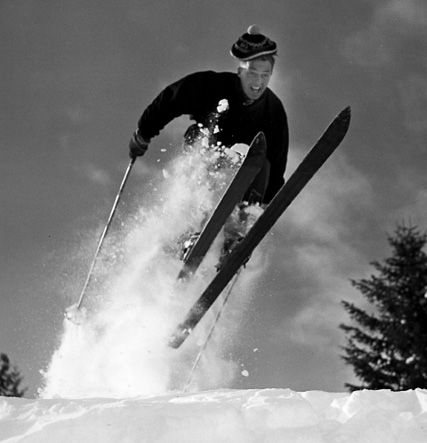
From Olympic racing to elite coaching, this once-and-future family has had a powerful impact on the sport.
Above: John Caldwell at home in Putney, Vermont, where he first started competing as a high-school student in the late 1940s. By 1951 (right), he was training with the U.S. nordic team for the 1952 Winter Olympics in Oslo.
The Caldwells are America’s first family of cross-country skiers. As elite athletes, coaches, ski technicians, organizational founders, retailers and advisors, the family and the sport have formed a multi-generational bond that goes back 70 years. In U.S. skiing, only the Cochrans come close.
On a breezy June day in Peru, Vermont, three generations of Caldwells—grandfather John, son Sverre, granddaughter Sophie and her husband, Simi Hamilton—gathered on the porch of Sverre’s home, with its sweeping view south to Stratton Mountain. They pieced together a family history that begins with John’s journey from the Putney School to Dartmouth College to the 1952 Olympics, stretches through Sverre’s seminal coaching gig at Stratton Mountain School, and strides into the present with Sophie and Simi’s leadership on the U.S. World Cup team.
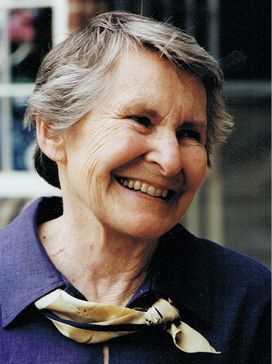
The family legacy has humble roots in late-1940s Vermont. Although a gifted downhill skier, John was a cross-country neophyte as a high-school athlete at Putney. In his first nordic race, he borrowed his sister’s clunky alpine skis (because they were smaller and lighter than his) and “basically ran around the course on skis,” he recalls. He finished in the top 15. Yet by the time John reached Dartmouth, his skills—and equipment—had improved sufficiently to enable him to compete as a four-event skier, in cross-country, jumping, slalom and downhill. He was named to the 1952 Olympic nordic combined team.
Grand as it might have been to go to the Games, he didn’t exactly receive the gilded Olympic treatment. Cross-country was little more than a blip on American skiing’s radar screen. “Not many ski clubs were promoting cross-country skiing,” John says, and the team essentially had no budget. Preparation for the Games in Oslo was an on-the-fly affair. Relegated to the margins, John and his teammates self-funded an impromptu camp in Sun Valley, where they didn’t always maintain an intensive focus on training. Enticed one day by fresh powder, they were spotted by a photographer who was so impressed by their downhill talents that he took publicity shots for the resort’s marketing campaign.
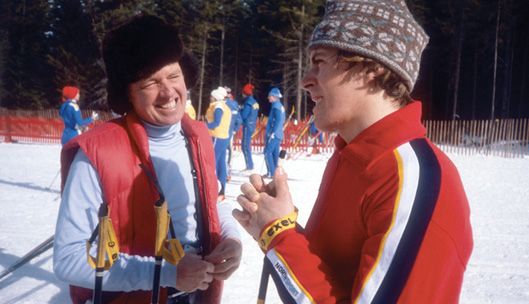
Not surprisingly, John’s Olympic performance in Oslo was less than stellar. “I never felt so unprepared for an athletic event in my life,” he says. He remembers making 11 jumps from the legendary Holmenkollen and falling six times. One inelegant but successful jump enabled him to qualify for the 18-kilometer cross-country event, in which he was 73rd among 75 finishers. More than 24 minutes behind the Norwegian winner, he managed to beat just one Australian skier.
That ignoble performance motivated John to embark on a long campaign to upgrade the stature of—and support for—cross-country skiing in America. In 1953, he launched a three-decade career of teaching and coaching at Putney while he and his wife, Hep, started a family (or, as Sophie teases her grandfather, “popping out kids”). Tim, Sverre, Peter and Jennifer formed the next generation to carry the family name forward. Meanwhile, John continued to burnish his own legacy.
In the 1960s and early 1970s, he was back on the national-team scene, coaching several Olympic and world championship teams, becoming the nordic representative on the U.S. Ski Team board, and writing a book, The Cross-Country Ski Book, the only one of its kind in the U.S. at that time. (The book’s success “kept me out of the poorhouse,” John says.) He was also founder of the New England Nordic Ski Association, whose prestigious annual award now bears his name.
Despite these efforts, acceptance of the sport was slow in coming. “Nobody paid attention to cross-country,” John says, and he remembers another USST board member telling him: “If you weren’t such a nice guy, we wouldn’t even have a cross-country program.” For the 1966 World Championship team, it took a $1,000 gift from a friend to pay for top-quality equipment for team members.
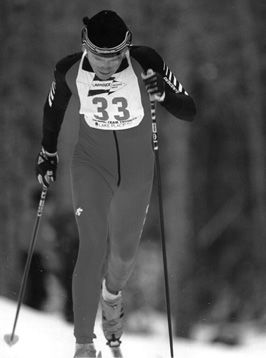
That was the world Sverre and older brother Tim entered in the late 1960s and early 1970s as they rose through the nordic ranks. Tim carried the family banner into elite racing, competing in the first of four Olympics as an 18-year-old in 1972. (Peter was also a successful XC racer, building an impressive collegiate record, while Jennifer would win the prestigious American Birkebeiner race in 1983.) During Tim’s 12-year Olympic run, between 1972 and 1984, respect for cross country finally began to take root. “A lot of things changed,” Tim says, and by 1984, “we were treated like kings compared with our predecessors.”
That was all relative, of course. By alpine standards, the American cross-country program was still a bare-bones operation. Team coaches “wore many hats,” says Tim—waxing skis, making travel arrangements, cooking meals, devising fitness programs. “In 1972, you never heard the term ‘wax tech.’ And even in 1984, we were doing a lot of waxing ourselves.” That wasn’t necessarily a bad thing. “There was something to be gained by getting a feel for your skis by waxing them.”
And in the absence of official support, says John, U.S. skiers might have had a few advantages over well-financed Scandinavian and Russian programs. Freed from sponsor obligations, for example, U.S. skiers could use any wax brands and combinations that they wanted. “We knew more about waxing than anyone else,” John says of the 1960s and 1970s. “We tried waxing innovations that might have given us an edge.”
Health issues—pneumonia and back problems—slowed Sverre’s athletic development. He stayed connected to the sport by dabbling in coaching as a Dartmouth student in the 1970s. But he found that coaching and athletic development hadn’t advanced much since John’s Olympic struggles in 1952.
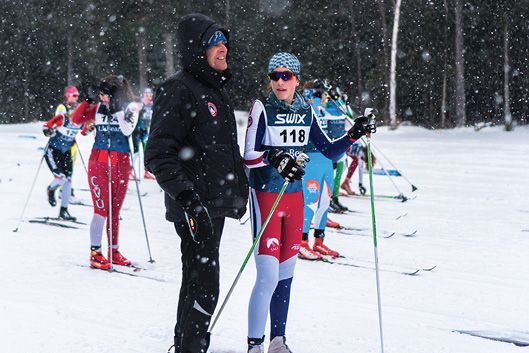
When Sverre took over the nordic program at Stratton Mountain School in the late 1970s, he was hired not because of his great expertise but simply because there wasn’t much competition. “There just weren’t that many experienced coaches,” he says. After all, there were no technical manuals for guidance (except perhaps for The Cross-Country Ski Book) and no great American mentors. The concept of the ski academy was essentially birthed with Burke Mountain Academy, founded in 1970, followed by Stratton Mountain School in 1972 and Green Mountain Valley School in 1973. But the academies’ focus was almost entirely on developing alpine athletes. Like John flying blind in preparing for the 1952 Olympics, Sverre had no template to guide him.
Left to his own devices, Sverre managed to turn the SMS nordic program into the best secondary-school program in the country. In a 40-year span beginning in the late 1970s, 16 Olympians have had SMS roots, and Sverre produced so many national-team members that the best number he can put on it is “30ish.” Among those elite skiers are Sophie and Simi, as well as Sophie’s cousin (and Tim’s son) Patrick and recent Olympic gold medalist Jessie Diggins.
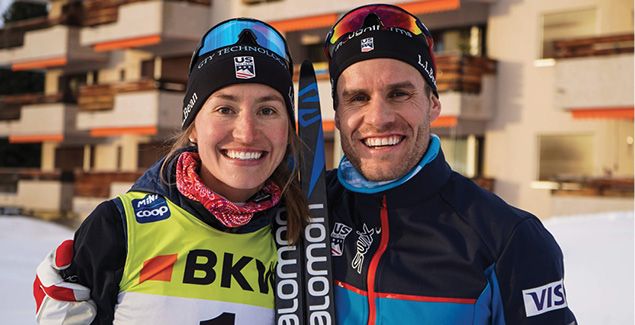
As a third-generation standard-bearer for the Caldwell legacy, Sophie claims she felt no pressure to live up to the family name. (“I took the pressure off because I wasn’t a very good athlete,” jokes Sverre.) But there were decided advantages to being a Caldwell: Sophie could tap into a deep reservoir of wisdom and experience.
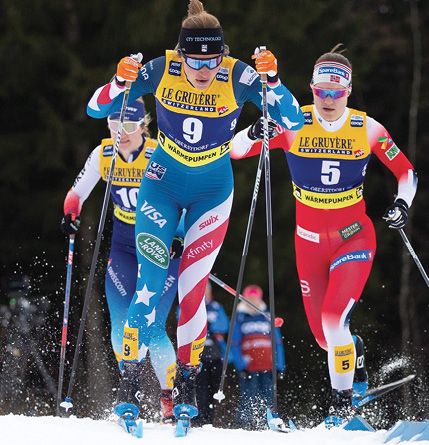
Thanks in part to John and Sverre, the national team has advanced by light years since the early 1950s. Both Sophie and Simi have been most successful as skate skiers in sprinting events. Sprinting wasn’t added to the roster of Olympic sports until 2002, and skating technique was just beginning to evolve in the early 1980s, when Tim was nearing the end of his competitive career. What Sophie and Simi are doing today was unimaginable in John’s time … or even in Tim’s. Sophie is a two-time Olympian who finished third in the 2017–2018 overall World Cup sprint standings; Simi, who grew up in Aspen, is a three-time Olympian who finished ninth in the overall sprint standings the following year.
Sophie and Simi are not alone in sustaining the family legacy. Sverre’s son Austin has followed his father into the collegiate coaching ranks. Patrick is now retired from the national team, but cousin Zach, proprietor of Caldwell Sports in Putney, is considered one of the best—if not the best—cross-country ski tech in the country. And when Sophie and Simi talk abstractly about having a family in the future, perhaps a fourth generation of Caldwells is preparing, prenatally, to carry the banner farther into the future.
They are, indeed, a once-and-future force of nature.
From Skiing History, Sept/Oct 2020

Table of Contents
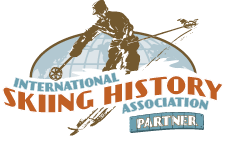
Corporate Sponsors
ISHA deeply appreciates your generous support!
World Championship
($3,000 and up)
Gorsuch
Polartec
Warren and Laurie Miller
World Cup ($1,000)
Aspen Skiing Company
BEWI Productions
Bogner
Boyne Resorts
Dale of Norway
Darn Tough Vermont
Descente North America
Dynastar | Lange | Look
Fairbank Group: Bromley, Cranmore, Jiminy Peak
Gordini USA Inc. | Kombi LTD
HEAD Wintersports
Hickory & Tweed Ski Shop
Intuition Sports, Inc.
Mammoth Mountain
Marker-Volkl USA
National Ski Areas Association (NSAA)
Outdoor Retailer
Rossignol
Ski Area Management
Ski Country Sports
Snowsports Merchandising Corporation
Sport Obermeyer
Sports Specialists, Ltd.
Sun Valley Resort
Vintage Ski World
World Cup Supply, Inc.
Gold ($700)
Race Place | BEAST Tuning Tools
The Ski Company (Rochester, NY)
Silver ($500)
Alta Ski Area
Boden Architecture PLLC
Dalbello Sports
Ecosign Mountain Resort Planners
Fera International
Holiday Valley
Hotronic USA, Inc. | Wintersteiger
MasterFit Enterprises
McWhorter Driscoll, LLC
Metropolitan New York Ski Council
Mt. Bachelor
New Jersey Ski & Snowboard Council
NILS, Inc.
Portland Woolen Mills
Russell Mace Vacation Homes
Schoeller Textile USA
Scott Sports
Seirus Innovations
SeniorsSkiing.com
Ski Utah
Tecnica Group USA
Timberline Lodge & Ski Area
Trapp Family Lodge
Western Winter Sports Reps Association
World Pro Ski Tour
The International Skiing History Association (ISHA) is grateful to the generous corporate sponsors who share our commitment to preserving skiing history and sharing it with the world. During this difficult time, your financial support is vital to our success, and we urge our members to support you in return. —ISHA Board of Directors


